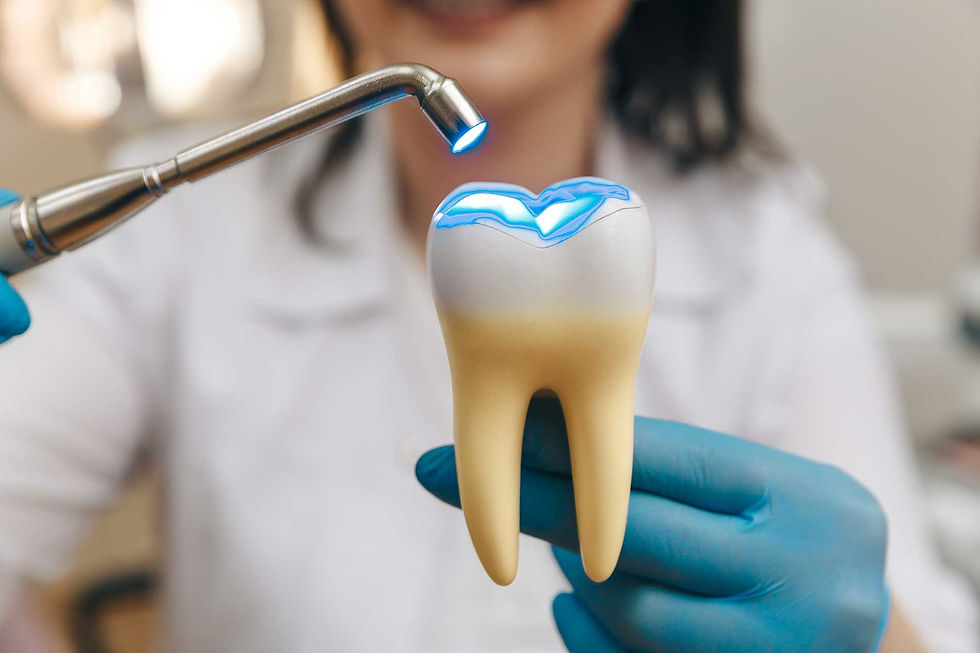Tooth Fillings vs. Root Canals: Which Treatment Is Right for You?
- dclinicdubai
- Jan 3
- 4 min read
When it comes to dental treatments, two of the most common procedures are tooth fillings and root canals. Both are designed to address dental issues caused by tooth decay, damage, or infection. If you're considering dental care in Dubai, understanding the differences between these two treatments can help you make an informed decision. In this article, we will compare tooth fillings in Dubai and root canals, helping you determine which treatment is right for your oral health needs.

What Are Tooth Fillings?:
A dental filling is used to restore a tooth that has been damaged by decay or trauma. Fillings are one of the most common treatments used to treat cavities and protect the tooth from further damage.
1. How Fillings Work:
Restoring the Tooth Structure: A filling is placed in the cavity after the decayed portion of the tooth is removed. The filling material (composite, amalgam, or porcelain) is used to restore the tooth to its original shape and function.
Preventing Further Decay: By filling the cavity, the treatment prevents bacteria from entering the tooth, reducing the risk of further decay or infection.
2. When Are Fillings Needed?:
Small to Moderate Cavities: Fillings are typically recommended when a cavity is small to moderate in size and hasn't yet affected the tooth's inner structures.
Tooth Sensitivity or Pain: Fillings can be used to alleviate discomfort caused by decay or small cracks in the enamel, helping to restore the tooth's function.
What Is a Root Canal?:
A root canal is a more complex procedure performed when tooth decay or damage has reached the inner pulp of the tooth. This procedure is typically needed when the tooth becomes infected or severely decayed.
1. How Root Canals Work:
Removing the Infected Pulp: During a root canal, the dentist removes the infected or damaged pulp from the center of the tooth. The area is then cleaned and sealed to prevent future infection.
Preserving the Tooth: Root canal treatment helps preserve the natural tooth, preventing the need for extraction. After the procedure, the tooth is typically restored with a crown to ensure its strength and function.
2. When Are Root Canals Needed?:
Severe Tooth Decay: Root canals are often necessary when decay has reached the tooth's pulp, causing pain, swelling, or infection.
Cracked or Fractured Teeth: If a tooth is cracked or fractured and the inner pulp is exposed, a root canal may be needed to save the tooth.
Tooth Fillings vs. Root Canals: Key Differences:
While both treatments aim to restore oral health, there are significant differences between tooth fillings and root canals in terms of the severity of the dental issue and the procedure involved.
1. Level of Damage:
Fillings: Ideal for small to moderate cavities where the decay is limited to the outer layers of the tooth. Fillings do not typically address deeper, more severe issues.
Root Canals: Recommended when the decay or damage has reached the pulp of the tooth, causing infection or intense pain. Root canals are necessary when a tooth is in danger of being lost due to advanced decay or injury.
2. Procedure Complexity:
Fillings: The filling procedure is relatively simple and can usually be completed in a single visit. The decayed portion is removed, and the filling material is placed to restore the tooth.
Root Canals: A root canal is a more involved procedure that may require multiple visits. The dentist must remove the pulp, clean the canal, and seal the tooth before restoring it with a crown.
3. Pain and Discomfort:
Fillings: After the procedure, you may experience mild discomfort or sensitivity, especially if the filling is placed in a large cavity. However, the recovery time is typically short.
Root Canals: Root canals tend to have a longer recovery period, as the tooth's interior has been treated. You may experience more significant discomfort or swelling after the procedure, though pain is usually manageable with medication.
4. Tooth Longevity:
Fillings: A properly placed filling can last for several years, depending on the material used and the size of the cavity. Fillings are often a durable solution for restoring tooth function.
Root Canals: While root canal treatments are highly effective in saving teeth, the tooth may require further restoration with a crown to provide long-term durability. A tooth that has undergone a root canal can last for many years if properly cared for.
When to Choose a Tooth Filling:
If you have a small to moderate cavity or minor damage to a tooth, a filling may be the best option for restoring the tooth's function. Fillings are suitable for addressing:
Minor Tooth Decay: When the decay has not yet affected the inner layers of the tooth.
Cosmetic Concerns: Fillings are often used to restore the appearance of a tooth after minor cracks or chips.
Prevention of Further Damage: By filling the cavity, the dentist prevents the decay from spreading and causing more severe issues.
When to Choose a Root Canal:
If the damage to your tooth is more severe, particularly if the infection has reached the pulp, a root canal may be the best treatment option. Root canals are ideal for:
Severe Decay: When the tooth has become infected or the pulp has been damaged beyond repair.
Pain or Swelling: If you are experiencing persistent pain, swelling, or sensitivity, a root canal may be necessary to save the tooth.
Tooth Preservation: If a tooth is severely damaged or infected, a root canal can help preserve the tooth and prevent extraction.
Conclusion:
Both tooth fillings and root canals are important treatments in modern dentistry, each serving a specific purpose depending on the severity of the dental issue. While fillings are ideal for addressing minor to moderate damage, a root canal is necessary when the infection or decay reaches the inner pulp of the tooth. If you’re in Dubai and facing a dental issue, it’s important to consult with a dentist to determine which treatment is right for you. By understanding the differences between these procedures, you can make an informed decision and restore your smile to its best condition.
Readmore about: How to Care for Your Tooth Fillings for Long-Lasting Protection


Comments